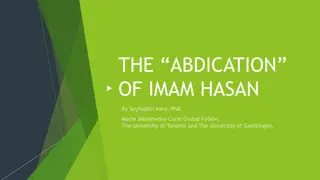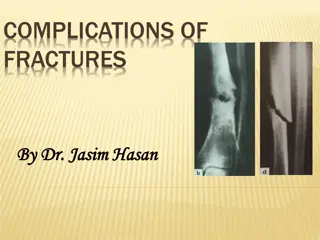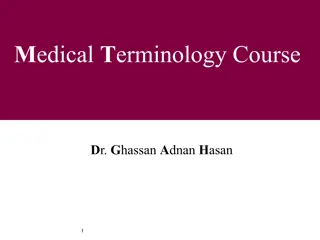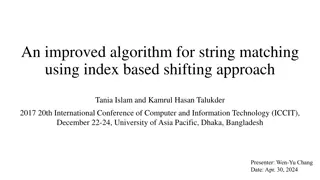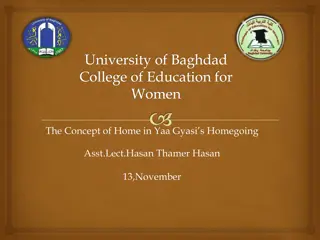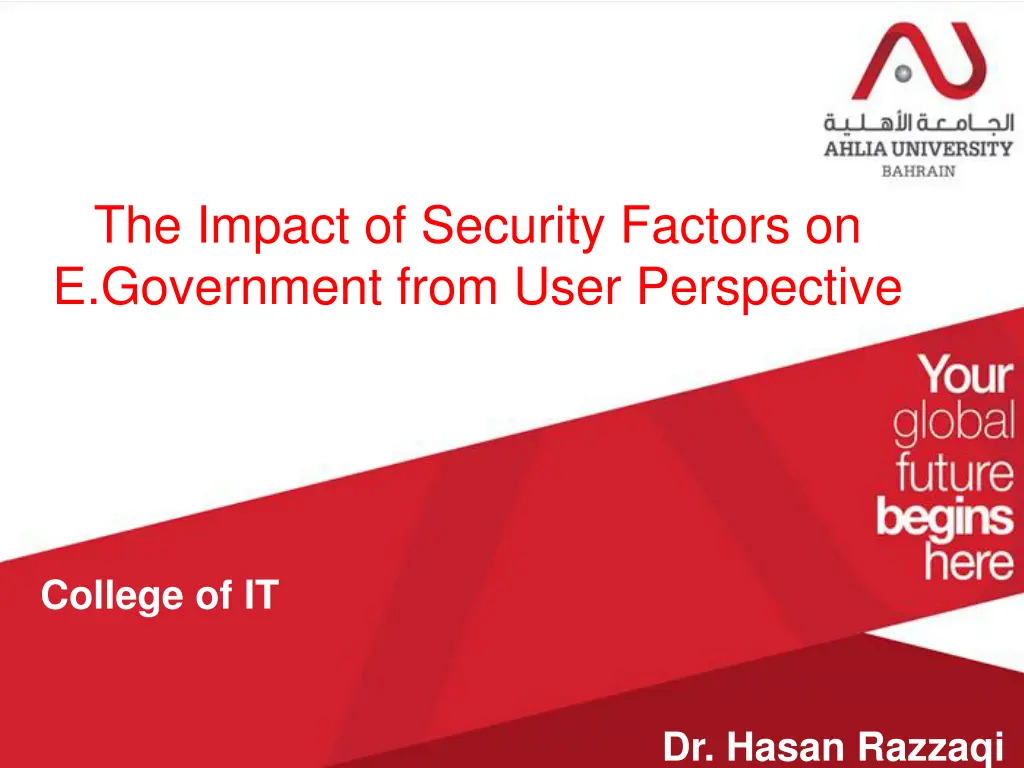
User-Centric Factors Impacting E-Government Security
Explore how user-centric factors influence the security of e-government services amidst changing technologies. Addressing issues related to user perceptions, trust, risk, and privacy to enhance e-government security.
Download Presentation

Please find below an Image/Link to download the presentation.
The content on the website is provided AS IS for your information and personal use only. It may not be sold, licensed, or shared on other websites without obtaining consent from the author. If you encounter any issues during the download, it is possible that the publisher has removed the file from their server.
You are allowed to download the files provided on this website for personal or commercial use, subject to the condition that they are used lawfully. All files are the property of their respective owners.
The content on the website is provided AS IS for your information and personal use only. It may not be sold, licensed, or shared on other websites without obtaining consent from the author.
E N D
Presentation Transcript
The Impact of Security Factors on E.Government from User Perspective College of IT Dr. Hasan Razzaqi
Agenda Research Background Problem definition Aim and Objectives Theoretical Framework Methodology Data Analysis and Finding Discussion Conclusion Dr. Hasan Razzaqi
Research Background Many governments have revolutionized the way the e.government services being delivered to the people, however these services found to have security problems (Ihmouda et al., 2015). i.e Change in ICT Many users found to have doubt on the level of availability, confidentiality, integrity, accountability, authenticity and reliability of the e-government services (Priyambodo, 2017) i.e incidents / perception Ensuring security while users transact via e-Government is a major challenge (Al-Shafi and Weerakkody, 2010). Literature identified many factors influencing e.government security (Shah et al., 2014), however not from user perspective. Dr. Hasan Razzaqi
Problem definition Factors concerning users of e.government are not well addressed in the literature specially e.government security from social science and management perspective (Shah et al., 2014). Lack of knowledge about user centric factors that can affect the success of e.government service including e.government security. Perception of lack of ease of use and usefulness of the technology (Ayyash et al., 2013). Perception lack of trust of users of e.government (Abu-Shanab and Al-Azzam, 2012). Perception lack of risk and privacy associated with the new technologies of e.government (Lim et al., 2015) Lack of knowledge of how e.government security affects government agencies and users. Dr. Hasan Razzaqi
Research Questions 1. What are the factors that can be considered as user- centric and affect e.government security? 2. How those factors affect e.government security when there is a change in technology? Dr. Hasan Razzaqi
Aim To examine how changing technology as a contextual factor is related to user centric e.government security Dr. Hasan Razzaqi
Objectives To study the various factors concerning users in the field of e.government in an environment characterized by changing technology. To elicit specific user-centric factors that could be related to e.government security with the support of theories or models. To conceive a model using the factors elicited above that could relate those factors based on theories, concepts and models found in the extant literature. To derive findings by testing the model and achieve the aim set. Dr. Hasan Razzaqi
Theoretical Framework Factors effecting e.government security (Direct / Indirect) Risk e-government security (Shah et al., 2014) Trust Risk (AlKalbani et al., 2015) TAM and behavior theories Ease of Use Trust (Ayyash et al., 2013) Usefulness Trust (Ayyash et al., 2013) Technology Trust (Abunadi, 2015) Socio-technical theory, HCI theory and acceptance theories Moderators Factors on Technology (Indirect) HCI Technology (Zhang et al., 2010) Privacy Technology (Lagzian and Naderi, 2015) Web Quality Technology ((Lagzian and Naderi, 2015) Contextual Factors on Trust (Indirect) Education level, Experience, Nationality (Kearney, 2015) Dr. Hasan Razzaqi
Theoretical Framework Research Model Perceived Ease of Use (PEOU) Perceived Usefulness (PU) H5a H5b HCI H3a (Interaction) H2 H1a H3b H4 E-Governemnt Security Technology Trust Risk H1b H1c Privacy Services Quality H6a H6b H6c Education Experience Nationality Dr. Hasan Razzaqi
Theoretical Framework Hypothesis H1a: Human computer interaction positively influences the relationship between e-Government technology and user centric e-Government security. H1b: User privacy positively influences the relationship between e-Government technology and user centric e-Government. H1c: Web design quality positively influences the relationship between e-Government technology and user centric e-Government security. H2: e-Government technology positively influences user trust in e-Government services. H3a: User trust on e-Government negatively influences user centric e-Government security H3b: User trust on e-Government negatively influences the risk felt by users of e-Government. H4: User felt risk negatively influences user centric e-Government security H5a: Perceived ease of use of e-Government services positively influences user trust in e- Government. H5b: Perceived usefulness of e-Government services positively influences user trust in e- Government. H6a: Education level of users positively influences user trust in e-Government. H6b: Experience of users in e-Government positively influences user trust in e-Government. H6c: Nationality of users influences user trust in e-Government. Dr. Hasan Razzaqi
Methodology The survey research method was used in this research (Pilot survey 52 valid responses and Main Survey 306 valid response) A questionnaire (58 questions) was used as the primary data collection tool to elicit the opinions of a large cross- section of population chosen as the sample. The primary subjects of the sample was the ordinary users of e.government services. The data statistical analysis tools (SPSS, Amos 19.0) (Validity test, Reliability test, Confirmatory Factor Analysis (CFA), Structure Equation Modelling (SEM), Path Analysis , Unidimensionality, average variance extracted (AVE) Dr. Hasan Razzaqi
Data Analysis and Finding Exogenous Endogenous Results of Hypothesis No. Hypothesis Latent Latent Hypotheses Explanation Constructs Construct verification Human computer interaction positively influences the relationship between e- Human computer interaction H1a HCI Technology Accepted Government technology and user moderates technology positively centric e-Government security User privacy positively influences the relationship between e-Government User privacy does not moderate H1b EP Technology Rejected technology and user centric e- technology Government security Web design quality positively influences the relationship between e- Service Web design quality moderates H1c Technology Accepted Government technology and user Quality technology positively centric e-Government security E-Government technology positively Technology positively and H2 influences user trust in e-Government Technology ET Accepted significantly influences ET services User trust on e-Government negatively ET positively and significantly H3a influences user centric e-Government ET ESec Accepted influences ESec security User trust on e-Government negatively ET negatively and significantly H3b influences the risk felt by users of e- ET ER Accepted influences ER Government User felt risk negatively influences user ER negatively and significantly H4 ER ESec Accepted Dr. Hasan Razzaqi centric e-Government security influences ESec
Data Analysis and Finding Perceived ease of use of e- government services positively PEOU positively and H5a PEOU ET Accepted significantly influences ET. influences user trust in e- government Perceived usefulness of e- government services positively PU positively and H5b PU ET Accepted significantly influences ET. influences user trust in e- government Education level of users positively Education is positively H6a influences user trust in e- Education ET Accepted correlated to ET. government Experience of users in e-government Experience is positively H6b positively influences user trust in e- Experience ET Accepted correlated to ET. government Nationality of users influences user Experience is not correlated H6c Nationality ET Rejected to ET. trust in e-government Dr. Hasan Razzaqi
Discussion Answer to research question 1 and 2 User centric factors have a strong influence on e.government security. Technology is a strong predictor of user centric e.government security mediated by trust. HCI and web quality design moderate the relationship between technology and user centric e.government security positively. Perceived ease of use and usefulness moderate the relationship between user trust and e.government security. Contextual factors user education and experience influence the relationship between user trust and e.government security Dr. Hasan Razzaqi
Conclusion Contribution to Knowledge Literature is silent on user centric factors affecting e.government security. Change in Technology has potential to bring out new situations not addressed in the literature and that need to be understood. Contribution to Theory The expansion of the application of socio-technical theory to understand how the concepts of e.government security manifest in reality Contribution to Methodology Empirical support from the conceptual model developed for answering the research questions Contribution to Practice (users can now know that there are user centric factors that affect e-Government security) Limitations of Research Conducted in Bahrain - small population More moderators may need to be brought in and investigated. The results of the research may not be generalizable Recommendations for Future Research Need further research in different territory larger than Bahrain -cloud computing. Dr. Hasan Razzaqi
References Abunadi, I. (2015) Characteristics of Electronic Integrated System and Trust in the Provider of Service , International Journal of Computer Applications, 132, 4(1). AlKalbani, A., Deng, H. and Kam, B. (2015) Organisational security culture and information security compliance for e-Government development: the moderating effect of social pressure , In PACIS 2015 (pp. 1-11). Association for Information Systems (AIS). Ayyash, M. M., Ahmad, K. and Singh, D.S.V. (2013) Investigating the effect of information systems factors on trust in e-Government initiative adoption in Palestinian public sector , Research Journal of Applied Sciences, Engineering and Technology, 5(15), pp.3865-3875. Kearney A. T. (2015) Lifting the barriers to ecommerce in ASEAN, Korea Lagzian, M. and Naderi, N. (2015) An Empirical Study of the Factors Affecting Customers Acceptance Intention of E-Invoice Services: The Case of Mashhad Electricity Distribution Company. Shah, M. H., Peikari, H. R., and Yasin, N. M. (2014) The determinants of individuals perceived e-security: Evidence from Malaysia , International Journal of Information Management, 34(1), pp. 48-57. Dr. Hasan Razzaqi
Thank you Dr. Hasan Razzaqi



